In the second post of the Getting Started with Python Integration to SAS® Viya® series we will learn about Working with CAS Actions and CASResults Objects. CAS actions are commands sent to the CAS server to run a task, and CASResults objects contain information returned from the CAS server. This post will cover a few basic CAS actions, and how to easily work with the information returned.
CAS Actions Overview
First, you need to understand CAS actions. From performing data preparation, modeling, imputing missing values, or even retrieving information about your CAS session, CAS actions perform a single task on the CAS server. CAS actions are organized with other CAS actions in a CAS action set. CAS action sets contain actions that are based on common functionality.
In the end, I like to think of CAS action sets as a package, and all the CAS actions inside an action set as a method.
Getting Started with CAS Actions
We will start with a basic CAS action to view all available loaded action sets in the current CAS session. Before you use any CAS action you must connect to the CAS server. For more information on connecting to the CAS server, visit Part 1 of the series.
I have already made my connection to CAS using SAS Viya for Learners, and my connection object is named conn.
display(conn) CAS('svflhost.demo.sas.com', 5570, 'peter.test@sas.com', protocol='cas', name='py-session-1', session='efff4323-a862-bd6e-beea737b4249') |
Next, to view all available action sets loaded in your CAS session use the actionSetInfo CAS action from the Builtins action set on the CAS connection object. CAS actions and CAS action sets are case insensitive, and you do not need to qualify the CAS action with the action set name (although it is best practice to include both). In the example below I qualify the CAS action.
The actionSetInfo CAS action returns the following output:
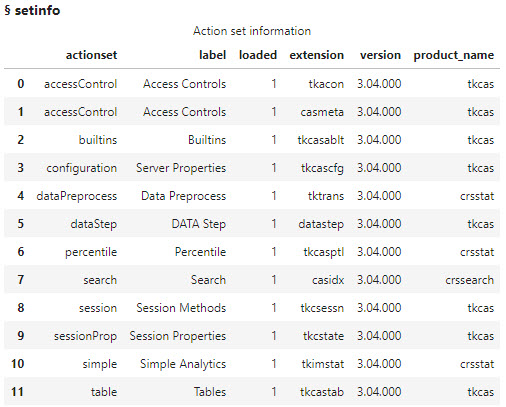
The output shows a list of the loaded action sets on the CAS server with additional information for each. With a quick scan, it almost looks like a Pandas DataFrame. However, let's go back and run the actionSetInfo CAS action, but this time use the Python type function to see the data type of the output.
type(conn.builtins.actionsetinfo()) swat.cas.results.CASResults |
The actionSetInfo CAS action returns a CASResults object. The million dollar question is, what exactly is a CASResults object?
CASResults Object
CAS actions return a CASResults object. A CASResults object is an ordered Python dictionary with additional methods and attributes. There are no specific rules about how many keys are contained in the CASResults object, or what values the keys return. That information depends on the CAS action used.
One thing to note is that CASResults objects are local on your client machine. That is, the data is not in CAS anymore, it has been processed by CAS and returned locally. This is something to keep in mind when you are working with big data in CAS and try to return more data than your local computer can handle.
Let's continue by examining the output from our previous example. The CASResults object returns one key named setinfo, and one value. You can quickly tell by looking at the output.
However, another method to view all the keys in the CAResults object is to use the Python dictionary keys method. In this example, it will return one key named setinfo.
conn.actionsetinfo().keys() odict_keys(['setinfo']) |
Be aware of how I specified the CAS action in the above example. This time I did not qualify it with the Builtins CAS action set. While you can specify with or without the CAS action set, I recommend to be consistent. I typically do not type the CAS action set. I'll keep that method moving forward.
To view a specific value of a CASResults object you can call the key like a typical Python dictionary. In this example you can call the setinfo key to return the key's value.
conn.actionsetinfo()['setinfo'] |
As mentioned earlier, the output seems to resemble a Pandas DataFrame. To confirm our suspicion, we can use the type function to see the data type of the value returned by the setinfo key,
type(conn.actionsetinfo()['setinfo']) swat.dataframe.SASDataFrame |
Interesting! The CASResults object contains a SASDataFrame for the setinfo key. What exactly is a SASDataFrame?
Understanding a SASDataFrame
A SASDataFrame is a subclass of a Pandas DataFrame. As a result, you can work with them as you normally would a Pandas DataFrame! Another thing to note is a SASDataFrame is local data. Again, as you use CAS you must be aware CAS can handle more data than your local computer can handle. When bringing data locally make sure it's usable on your local machine. We will discuss this in future posts.
Let's work with the SASDataFrame. First, I will create a new variable named df that holds the SASDataFrame from the actionSetInfo action.
df = conn.actionsetinfo()['setinfo'] |
Next, I'll use some Pandas methods on the df object. Let's start with the head method to view the first five rows.
df.head() |
Or filter the data using the loc method. In this scenario I want to find all action sets with the name simple, and return the actionset and label columns.
df.loc[df['actionset'] == 'simple', ['actionset', 'label']] |
Or check unique values of the product_name column by using the value_counts method.
df['product_name'].value_counts() tkcas 8 crsstat 3 crssearch 1 |
Or...
No that's it. I think you get my point! You can work with a SASDataFrame object like you would a Pandas DataFrame!
CASResults Object With Multiple Keys
Lastly, let's use another CAS action, but this time the CASResults object contains multiple keys, with multiple value types.
In this example I use the serverStatus CAS action from the Builtins CAS action set. The CAS action returns the status of the server.
conn.serverstatus() |
From the looks of the output, I see there are three keys; About, server, and nodestatus. However, let's check our assumption by using the keys method on the CASResults object.
conn.serverstatus().keys() odict_keys(['About', 'server', 'nodestatus']) |
In the output there are three keys as expected. Let's look at the data type of each key by writing a quick Python loop to print the name of the key and the value type returned by that key.
for key,value in conn.serverstatus().items(): print('Key : {}, Value Type : {}'.format(key,type(value))) Key : About, Value Type : <class 'dict'> Key : server, Value Type : <class 'swat.dataframe.SASDataFrame'> Key : nodestatus, Value Type : <class 'swat.dataframe.SASDataFrame'> |
The serverStatus CAS action contains three keys, one key contains a dictionary object, and the other two keys contain a SASDataFrame.
Summary
In conclusion, understanding CAS actions and the CASResults objects are essential when working with CAS. A couple of key points to remember:
- CAS actions reside in CAS action sets and perform a single task on the CAS server.
- CAS actions return a CASResults object, which is simply a Python dictionary.
- A CASResults object contains a single or multiple keys, corresponding to a value or values of any data type.
- A SASDataFrame resides in a CASResults object, and is a subclass of a Pandas DataFrame.
That was a quick overview of a few basic CAS actions, and how to work with the CASResults objects they return. You can check out the SAS documentation below for all available CAS Actions.
Additional Resources
SAS® Viya® Actions and Action Sets by Name and Product
Getting Started with Python Integration to SAS® Viya® Series Index

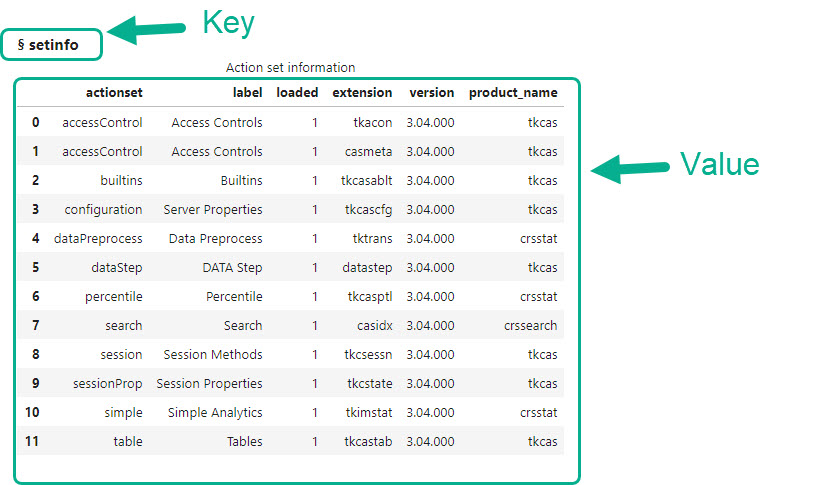
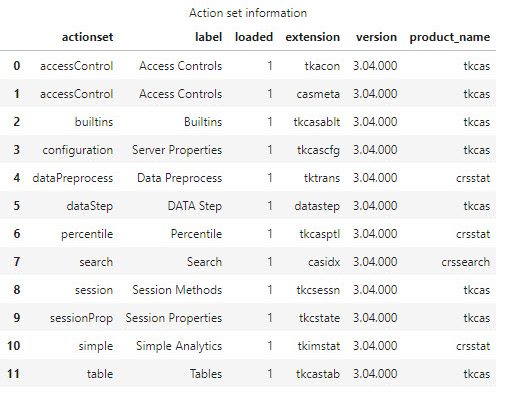
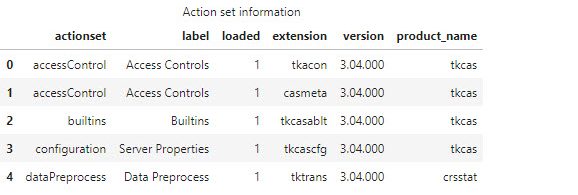

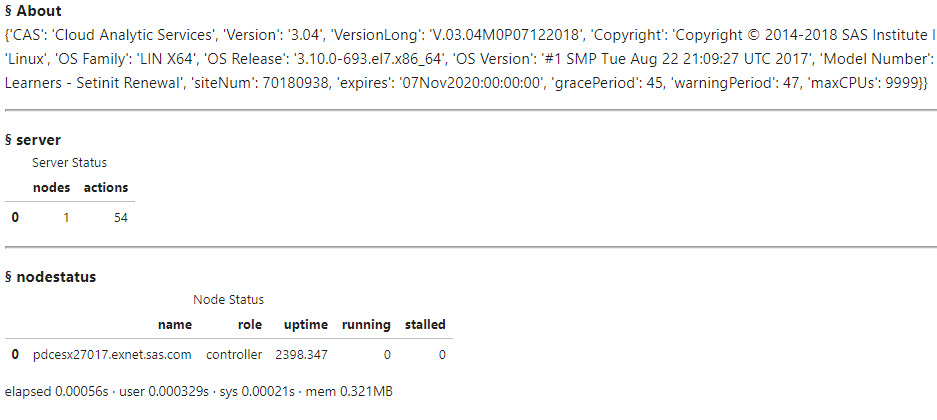

2 Comments
Great Blog, Peter, thanks! I have been struggling with these concepts for a while and you've made them crystal clear
Glad to hear! If you have any questions feel free to reach out!